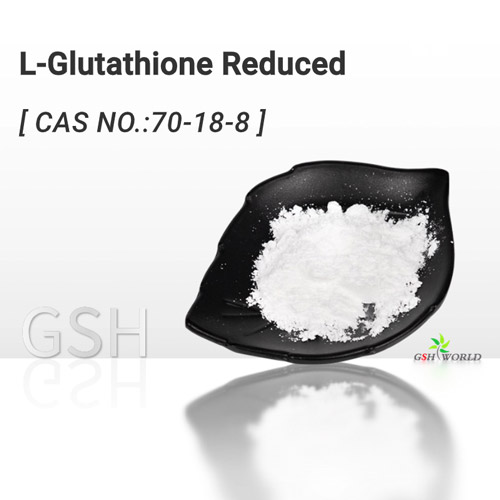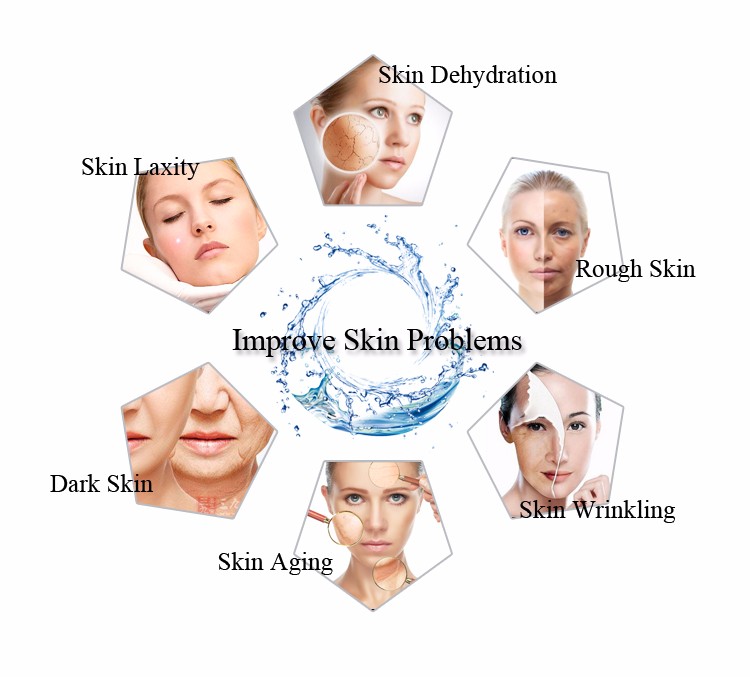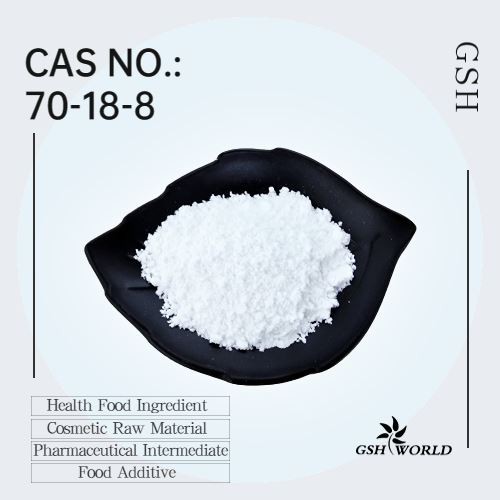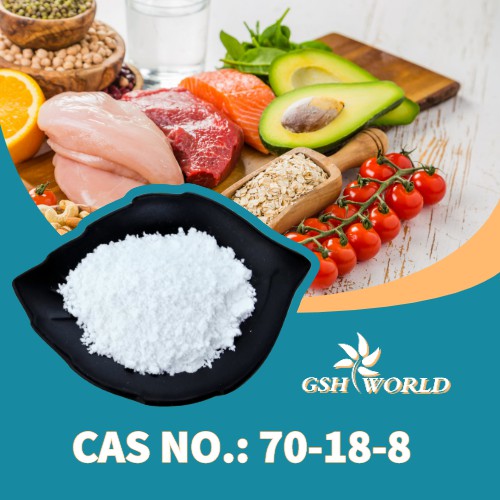Glutathione (GSH) is a tripeptide that is produced endogenously in the human body. It is present in the cells of plants and animals, and is the highest concentration of antioxidant in cells.
For the human body, GSH plays an extremely important role in maintaining the integrity and healthy operation of cells. The endless supply of glutathione is an indispensable element for the functional operation of antioxidant, free radical scavenging, detoxification, and other functions within cells.
Glutathione is a highly recommended dietary supplement in the current health food industry.
The cosmetics industry also highly values GSH, mainly due to its whitening, antioxidant, and heavy metal chelating functions.
There is no upper limit on the amount of glutathione added to skincare products.
detoxification theory of glutathione
The term “detoxification” starts with the role of GSH in the liver. The job of glutathione is to help eliminate foreign toxins.

The so-called toxins generally refer to free radicals, heavy metals, certain drugs, etc. The special structure of glutathione can combine with these toxins to transform into low toxic or non-toxic substances and excrete them out of the body.
Take the well-known painkillers in daily life as an example. Take Tylenol and Panadol orally, with the chemical name acetaminophen.
About 4% of this drug metabolized by the liver. Under normal circumstances, it preferentially binds to GSH in the liver and excreted from the body through urine.
When taken in large amounts for a long time or suddenly, insufficient GSH in the liver may lead to liver cell necrosis. A daily dose of more than 3 grams of Panadol can cause liver damage if taken for a long time.
Glutathione is used as an amino acid nutritional supplement in the utilization of drugs. Mainly used by intramuscular or intravenous injection. Typically, adults receive 100-200 mg per day.
【 Indications 】 Maintain normal liver function.
【 Usage and Dosage 】 After dissolving with the attached solution, it is usually administered to adults once, 100-200mg, via intramuscular or intravenous injection, with appropriate changes depending on age and symptoms. This medicine is limited to use by physicians.
Biochemical effects
(1) The activation effect of oxidation-reduction
Reduced Glutathione exists in living tissues and can easily reduce H+to hydrogen acceptors, becoming an oxidized Glutathione. It is then reduced to a reduced Glutathione by NADPH within the tissue, playing an important role in the redox process of living organisms.
(2) Enzyme activation effect
Enzymes containing SH groups (Carboxylase, Monoamine oxidase, Transaminase, Lipase Trypsin, etc.) oxidized, and most of them become inactive S-S type. S-S type enzymes reduced to – SH type, and then undergo biotransformation.
(3) Detoxification effect
The metabolic process of oxidation, reduction, and hydrolysis in the body produces harmful substances, which are then detoxified by Glucuronic Acid, Glycine, and Mercapturic Acid. GSH can promote the detoxification function of chelation.
(4) Effect on patients with liver diseases
When liver disorders occur, various metabolic disorders occur. Glutathione is related to metabolism and can improve liver dysfunction caused by liver dysfunction.
(5) Anti allergic effect
The occurrence of allergic symptoms caused by the intervention of chemical mediators such as Histamine, Acetylcholine, Serotonin, Bradykinin, etc.
Whitening Theory of Glutathione
Oral or injection of GSH as a skin whitening agent has always been controversial.

In addition to its significant antioxidant and detoxification properties, the discovery of its anti melanin production properties has also contributed to the growth of business opportunities for oral and injectable glutathione.
We can learn about the mechanism of action of GSH as a systemic skin whitening agent and scientific evidence for evaluating its whitening efficacy from this review of GSH literature.
The literature mentions that the skin whitening effect of glutathione caused by the direct and indirect inhibition of tyrosinase, as well as the conversion from true melanin to brown melanin.
At present, there are three randomized controlled trials that support the whitening effects of topical and oral GSH, which are good and safe. However, key issues such as the duration of treatment and the persistence of skin whitening effects have yet to answered.
When it comes to exploring the whitening effect of oral glutathione alone, two studies in historical literature have evaluated the efficacy of oral GSH as a skin whitening agent, and the results show that it is effective.
Firstly, the dosage is 500 mg capsules per day, with a duration of 4 weeks and a population of 60 people.
Secondly, the dosage is 500 milligrams of oral tablets per day, with a duration of 8 weeks and a population of 30 people.
- Reference 1 Glutathione as a Skin Whitening Agent: Facts, Myths, Evidence, and Controversy
- Indian J Dermatol Venereol Leprol-2016 May Jun; 82 (3): 262-72. doi: 10.4103/0378-6323.179088
- Ref 2 Glutathione as an oral whitening agent: a randomized, double-blind, placebo-controlled study.
- Glutathione as an oral lighting agent: A randomized, double blind, placebo controlled study J Dermatolog Treat 2012; 23:97-102
- Research on the safety and efficacy of a novel glutathione formulation as a skin whitening agent for Filipino women. An open label, single arm trial of the safety and efficacy of a novel preparation of glucose as a skin lighting agent in Filipino women Int J Dermatol 2016; 55:153-7
How much glutathione does it take to be effective? Is it safe?
The evaluation of oral whitening effect in the literature shows that the oral dose is 500 mg/day, but the duration is not long, with a maximum of 2 months (8 weeks). This cannot guarantee such a dosage. Longer security. According to relevant data, it seems that there is no clear scientific basis for the recommended oral dosage of GSH and the duration of continuous use.

Is it relatively safe to directly refer to the dose of injection “100-200 mg per dose for adults” and adjust it further?
Health supplements with a recommended daily consumption of over 500 milligrams can purchased online through foreign websites. Is there any irrationality in the safety dose? It’s a question that really needs to taken seriously. Any nutritional supplement that is excessive is equivalent to a risk.
A literature review shows that human trials conducted before 2013 have shown that oral glutathione supplements have almost negligible effects on increasing the concentration of GSH in human plasma.
Only two conclusions support the improvement after oral administration, but both studies used specific brands of glutathione produced by companies that funded the trial.
In other words, the actual absorption of GSH into the bloodstream after oral administration through the gastrointestinal tract very limited. This involves the fact that oral glutathione has a low bioavailability in the human body, and indirectly supports that a daily intake of 500 milligrams should be safe. (To put it simply, it won’t be absorbed, and eating as much is safe)
So, whether it’s antioxidant, detoxifying, or whitening,
the challenge for businesses is to achieve some results through oral administration, so that GSH can truly absorbed.
Perhaps some people wonder why the bioavailability of glutathione is so low when taken orally? This is because of the intestinal γ- Glutamyltransferase( γ- Glutamyltransferase hydrolyzes the tripeptide structure of GSH and degrades it into three amino acids (glutamic acid, cysteine, and glycine) that each have their own properties, making it difficult to directly utilize glutathione supplemented through diet.
Another earlier study on the systemic utilization of GSH actually yielded lackluster results. Studies have shown that even oral administration of 3 grams of high single dose GSH cannot increase the level of glutathione in the blood to a clinically meaningful level.
- Ref 4 Randomized controlled trial of oral glutathione supplements on in vivo glutathione storage
- Randomized controlled trial of oral glucose supplementation on body stores of glucose Eur J Nutr 2015; 54:251-63
- Ref 5: Increased protein binding forms of glutathione in human blood after oral administration of glutathione
- Increase in the process around form of glutathione in human blood after the oral administration of glutathione J Agric Food Chem 2014; 62:6183-9
- Study on the bioavailability of innovative cheek formula with reference 6 glutathione
- Bioavailability Study of an Innovative Orbital Formula of Glutathione Oxid Med Cell Longev 2016; 2016: 3286365 Doi: 10.1155/2016/3286365
- The systematic utilization of oral glutathione in ref 7.
- The systemic availability of oral glucose European Journal of Clinical Pharmacy 1992; 43 (6): 667-669. doi: 10.1007/BF02284971
What foods contain glutathione?
The robust liver can produce 8-10 grams of glutathione per day and distribute about 80% of it to other tissues for work through the bloodstream.
Regardless of the bioavailability of consuming glutathione,
let’s first understand the content of GSH in commonly consumed foods in daily life.

Asparagus is the food with the highest content of glutathione in vegetables and fruits. Fresh asparagus has a glutathione content of 260-400 mg/kg, and avocado also has a high GSH content.
Fresh slaughtered beef muscle contains 250-750 milligrams per kilogram,
while frozen beef muscle (frozen, trade product) contains 175 milligrams per kilogram.
Regarding the content of glutathione in vegetables, fruits, and meat,
it is very special that the content is only high when the meat is fresh, and high when the vegetables and fruits are uncooked.
For people who accustomed to cooked food, this also expresses the difficulty of obtaining the necessary amount of glutathione from their diet.
Supplementing glutathione in one step (directly into the bloodstream) is certainly the fastest and most accurate. But if it’s not possible, try a different path. Glutathione is originally produced through endogenous synthesis, and external supplementation may not necessarily be glutathione. It can a material required for the human body to synthesize glutathione. What is the material of glutathione? It is glutamic acid, L-cysteine, and glycine, three amino acids. The first step in biosynthesis is the binding of glutamic acid to L-cysteine.
Foods rich in glutamic acid, such as tomatoes, cheese, mushrooms, and beans.
L-cysteine mainly in Foods rich come from animals, such as fish, pork, seafood, shrimp, visceral organs, wheat germ, oats, and other high-quality protein foods.
Foods rich in glycine are extremely common, and most high protein foods contain them, such as fish, meat, beans, and dairy products.
Glycine and glutamic acid, belonging to the sweet and fresh amino acids,
originally exist in high proportion in various processed seasonings in daily life, such as soy sauce,
black pepper sauce, chicken soup chunks, corn broth, instant noodle seasoning bags, and various flavors of potato chip cookies.
So, among the three materials of glutathione,
the only one that not easily consumed in sufficient amounts in the diet L-cysteine. also believed by the World Health Organization that infants and young children may have insufficient intake of amino acids.
ref 8 Pressman, A.H. 1997. The GSH phenomenon: Nature’s most powerful antioxidant and healing agent: Glutathione. Marten press, New York.

